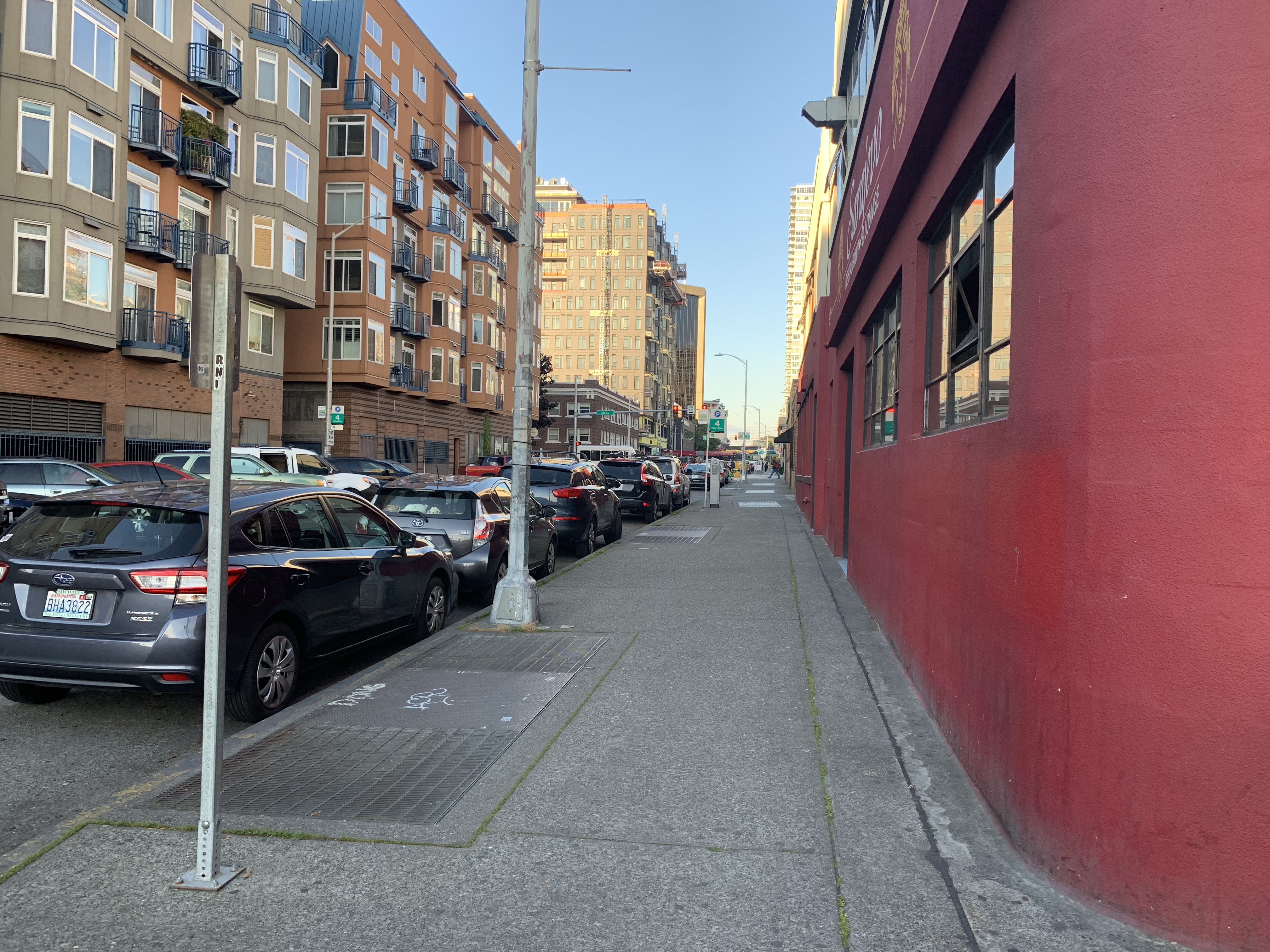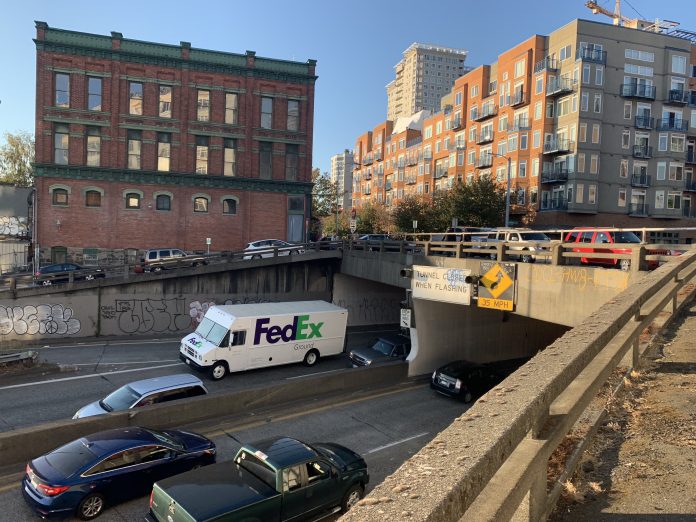The tunnel closes in early 2019, but WSDOT and the City of Seattle have not yet committed to plans for Battery Street’s future. Recharge the Battery wants to change that.
To mark the permanent closure of the Alaskan Way Viaduct and Battery Street Tunnel, the Washington State Department of Transportation (WSDOT) has organized a Step Forward event weekend on February 2-3, 2019. On those dates, the Viaduct and Battery Street Tunnel will be taken over by activities such as a fun run, bike ride, and art festival.
For many people it will be both the first and last time they explore the Viaduct and Battery Street Tunnel outside of a car. WSDOT has marketed the event as a chance to, “Experience the new tunnel, say goodbye to the viaduct, and hello to the future waterfront.”
Left out from the Step Forward tagline is any reference to the Battery Street Tunnel. While it may seem like a small oversight, the omission is significant–and not unusual. Throughout the history of the SR-99 project, the Viaduct has soaked up the limelight, while the Battery Street Tunnel has remained in its shadow.
Dismayed by lack of attention being paid to the fate of the Battery Street Tunnel, a group of Belltown community activists founded the Recharge the Battery initiative in 2017.
Their plans started out as ambitious. Taking inspiration from the Lowline, a subterranean park in New York City, Recharge the Battery sought to preserve the Battery Street Tunnel as an open public space.
However, dissuaded by the budget of $100 million or more required to reinforce the tunnel for current seismic codes and complete necessary utility work, the Seattle City Council voted to decommission the tunnel last March.
Sally Bagshaw, one of two City Councilmembers who voted in support of the project, admitted her yes vote was mostly symbolic. “The visions… struck me as ranging from brilliant, to economic-development opportunities, to fanciful. That said, I feel we’re a little too late,” said Bagshaw in a Seattle Times article.
“Things went a little sideways at the end,” admitted Aaron Asis, one of the founders of Recharge the Battery, “but we gained a lot of momentum leading up to the City Council vote.”
Recharge the Battery decided to accept the City Council vote as an opportunity to recalibrate rather than give up.
“If you ever looked our plans in detail, there were always four parts to the plan, and the tunnel was just one of them,” said Asis. “The other three parts were the Battery surface street, as well as the North and West ends of the tunnel. We decided accept the loss of the tunnel and move forward focusing on the other three opportunities that exist.”

On the Battery – A New Campaign Focus
The organization has continued to lobby for a scaled back, more practical vision for the Battery Street Corridor and its two portal sites. Renamed as “On the Battery,” the campaign now calls for improvements to the surface level.
From Recharge the Battery’s perspective, there remains a lot that still can be done. The presence of the tunnel beneath Battery Street for the past 65 years has resulted in the current streetscape, which is dotted with noisy vents and devoid of trees, because tree roots could compromise the tunnel’s ventilation system. The result is a corridor stretching from Denny Way to 1st Avenue that is populated by parked cars, but nearly absent of pedestrian and commercial activity.
“Battery Street is kind of a dreadful experience,” said Asis. “That has been long accepted by the community and the people in Belltown. But now to accept Battery Street to continue on its current state when the tunnel is no longer there would be a mistake.”
Recharge the Battery is currently trying to work with Seattle Department of Transportation (SDOT) and WSDOT to ensure that they include some provisions for trees while filling in the tunnel so that street experience can be improved.
“There are not any provisions in the current plan to improve Battery Street and we feel that is unacceptable,” said Asis.
Currently more flexibility exists on Battery Street between 1st Avenue and 3rd Avenue because the street does not have bus lanes in that segment. The hope is that a lane of traffic in this stretch can be reclaimed and used to add greenery to the street, ideally in the form of green stormwater infrastructure like bioswales.
Worries that Battery Street Could Be Overlooked
At a minimum of 15 months to complete, decommissioning the Battery Street Tunnel will take significantly longer than the demolition of the Viaduct, and will not be completed until 2020 or 2021.
Activists want to make sure the difficulties Belltown residents will deal with will have a purpose beyond closure of the tunnel.
“I’m willing to endure whatever construction periods SDOT/WSDOT deems necessary as long as what results are a concerted improvement over what is there now,” said Ryan Hendryx, Belltown resident and member of Recharge the Battery. “Status quo is unacceptable.”
Both members of Recharge the Battery and Belltown community residents fear that in a rush to complete the decommissioning WSDOT’s contractor Kiewet could leave the sites in a state that will be difficult to work with for future projects, particularly the West Portal entrance at 1st Avenue.
“We are concerned that they will just put up some barbed wire fencing and leave the lot vacant for an undetermined period of time,” said longtime Belltown resident Jackie Swarts, whose condominium overlooks the site. “There’s real a rush to get the Viaduct down and the tunnel closed. As a result important parts of the project, like the future of this site, could be overlooked.”
Swarts has become accustomed to the clamor of traffic entering the tunnel beneath her building, but she dreams of the day when she will be able to open her windows in summertime and still sleep peacefully. Like many Belltown residents, Swarts would like to see the site transformed into green space, in particular a park that will be connected by landscaped walking paths to the future waterfront.
Her neighbor and fellow Belltown community advocate Kay Smith-Blum, agrees that the portal site would serve the community best as a park. “While the waterfront project will add some greenery to the downtown, it’s not going to add enough. We need green space that local people will use and enjoy.”
The request for open space at the West Portal site has been repeated by many different community members to Recharge the Battery, who held a public outreach event in conjunction with the Seattle Design Festival this past Fall.
Recharge the Battery believes it is important that SDOT, WSDOT, and the City of Seattle understand that it would be unacceptable to leave the Battery Street portal sites decommissioned, but otherwise untouched, for a length of time.
As a result, they are trying to generate energy around “conceptual buy-in” for how improvements to the Battery Street Corridor could positively impact the Belltown community as they actively gather information about the feasibility of their improvement concepts. This is a strategic approach.
“Once you get buy-in, you can lobby for implementation dollars,” said Asis.
A major worry is that clean up could further delay future projects. Recharge the Battery is currently working closely with City Council to ensure the West Portal site is left in a state that can easily be transformed into open space after the tunnel decommissioning is completed.
“Our goal is for the the site to be left in a condition that we can work with,” said Asis, “because this would alleviate some costs. If the ground is left in decent condition and not super toxic, the relative cost of planting some trees and doing modest landscaping is very affordable.”
Optimism for the Future
Recharge the Battery has always been highly creative in its concepts for the future of Battery Street, and it’s conceptual designs have evolved overtime with the changing circumstances. At its heart, however, has always been the plan to restore a “soul” to the Battery Street Corridor.
The current visions emphasize greenery and sustainability. In this version of the future, after the Battery Street Tunnel is decommissioned the surface street will be lined with shade trees planted in tree pits that provide biofiltration to stormwater runoff, the West Portal will be transformed into a public park with an urban orchard supplying fresh produce to the community, and the North Portal near Aurora will become a green boulevard.
But none of those things will happen without firm commitments from city and state agencies, in particular WSDOT. What the Recharge the Battery is seeking more than anything else is commitment to plans for the future. Fortunately, general receptiveness to the “On the Battery” campaign has been positive and conversations with both the City Council and WSDOT are ongoing.
“At this point we are just trying to leverage what’s possible,” said Asis. “We have our ideals, which is where we are going to start, I just have no idea where we are going to end.”
Natalie Bicknell Argerious (she/her) is a reporter and podcast host at The Urbanist. She previously served as managing editor. A passionate urban explorer since childhood, she loves learning how to make cities more inclusive, vibrant, and environmentally resilient. You can often find her wandering around Seattle's Central District and Capitol Hill with her dogs and cat. Email her at natalie [at] theurbanist [dot] org.


